New Strategy to Maximize Phosphorus Utilization of Sewage Sludge Incineration Ash for Struvite Crystallization
Abstract
1. Introduction
2. Materials and Methods
2.1. Elution of Phosphorus from SSA in Acid and Alkaline Conditions
2.2. Re-Elution of Phosphorus from Residue of Alkaline Treatment
2.3. Application of Phosphorus Eluates to Struvite Crystallization
2.3.1. Single Injection of Three Types of Eluates
2.3.2. Sequential Injection of Two Types of Eluates
2.4. Analytical Methods
3. Results and Discussion
3.1. Characterization of Phosphorus Leaching from SSA by Acid and Base
3.2. Re-Elution of Phosphorus from Residue of Alkaline Treatment
3.3. Application of Each Phosphorus Eluate to Struvite Crystallization
3.3.1. Application of a H2SO4 1 N_eluate
3.3.2. Application of a NaOH 1 N_eluate
3.3.3. Application of a (NaOH+H2SO4)_eluate
3.4. Combined Application of NaOH 1 N_eluate and (NaOH+H2SO4)_eluate to Struvite Crystallization
4. Conclusions
Author Contributions
Funding
Data Availability Statement
Conflicts of Interest
References
- Le Corre, K.S.; Valsami-Jones, E.; Hobbs, P.; Parsons, S.A. Phosphorus recovery from wastewater by struvite crystallization: A review. Crit. Rev. Environ. Sci. Technol. 2009, 39, 433–477. [Google Scholar] [CrossRef]
- Desmidt, E.; Ghyselbrecht, K.; Zhang, Y.; Pinoy, L.; Van der Bruggen, B.; Verstraete, W.; Rabaey, K.; Meesschaert, B. Global phosphorus scarcity and full-scale P-recovery techniques: A review. Crit. Rev. Environ. Sci. Technol. 2015, 45, 336–384. [Google Scholar] [CrossRef]
- Zheng, Y.; Wan, Y.; Zhang, Y.; Huang, J.; Yang, Y.; Tsang, D.C.; Wang, H.; Chen, H.; Gao, B. Recovery of phosphorus from wastewater: A review based on current phosphorous removal technologies. Crit. Rev. Environ. Sci. Technol. 2023, 53, 1148–1172. [Google Scholar] [CrossRef] [PubMed]
- Park, N.R.; Chang, H.Y.; Jang, Y.J.; Lim, H.M.; Jung, J.H.; Kim, W.J. Critical conditions of struvite growth and recovery using MgO in pilot scale crystallization plant. Water Sci. Technol. 2020, 81, 2511–2521. [Google Scholar] [CrossRef]
- Liu, X.; Wen, G.; Hu, Z.; Wang, J. Coupling effects of pH and Mg/P ratio on P recovery from anaerobic digester supernatant by struvite formation. J. Clean. Prod. 2018, 198, 633–641. [Google Scholar] [CrossRef]
- Shih, Y.J.; Abarca, R.R.M.; de Luna, M.D.G.; Huang, Y.H.; Lu, M.C. Recovery of phosphorus from synthetic wastewaters by struvite crystallization in a fluidized-bed reactor: Effects of pH, phosphate concentration and coexisting ions. Chemosphere 2017, 173, 466–473. [Google Scholar] [CrossRef] [PubMed]
- Ma, J.; Yang, R.; Yu, X.; Zhao, Y.; Sang, Q.; Wang, F.; Chen, Y. Investigation of anaerobic side-stream phosphorus recovery and its effect on the performance of mainstream EBPR subjected to low-consumption. Water Sci. Technol. 2019, 80, 1944–1955. [Google Scholar]
- Forrest, A.L.; Fattah, K.P.; Mavinic, D.S.; Koch, F.A. Optimizing Struvite Production for Phosphate Recovery in WWTP. J. Environ. Eng. 2008, 134, 395–402. [Google Scholar] [CrossRef]
- Taddeo, R.; Lepistö, R. Struvite precipitation in raw and co-digested swine slurries for nutrients recovery in batch reactors. Water Sci. Technol. 2015, 71, 892–897. [Google Scholar] [CrossRef]
- Nieminen, J. Phosphorus Recovery and Recycling from Municipal Wastewater Sludge. Master’s Thesis, Aalto University, Espoo, Finland, 2010. [Google Scholar]
- Ueno, Y.; Fujii, M. Three years experience of operating and selling recovered struvite from full-scale plant. Environ. Technol. 2001, 22, 1373–1381. [Google Scholar] [CrossRef]
- Cullen, N.; Baur, R.; Schauer, P. Three years of operation of North America’s first nutrient recovery facility. Water Sci. Technol. 2013, 68, 763–768. [Google Scholar] [CrossRef]
- Marchi, A.; Geerts, S.; Weemaes, M.; Wim, S.; Christine, V. Full-scale phosphorus recovery from digested waste water sludge in Belgium–part I: Technical achievements and challenges. Water Sci. Technol. 2015, 71, 487–494. [Google Scholar] [CrossRef]
- Moerman, W.; Carballa, M.; Vanderkerckhove, A.; Derycke, D.; Verstraete, W. Phosphate removal in agro-industry: Pilot and full-scale operational considerations of struvite crystallization. Water Res. 2009, 43, 1887–1892. [Google Scholar] [CrossRef]
- Remy, M.; Driessen, W.; Hendrickx, T.; Haarhuis, R. Recovery of Phosphorus by Formation of Struvite with the PHOSPAQ™ Process. In Proceedings of the 18th European Biosolids and Organic Resources Conference, Manchester, UK, 18–20 November 2013. [Google Scholar]
- Krüger, O.; Adam, C. Recovery potential of German sewage sludge ash. Waste Manag. 2015, 45, 400–406. [Google Scholar] [CrossRef]
- Herzel, H.; Krüger, O.; Hermann, L.; Adam, C. Sewage sludge ash—A promising secondary phosphorus source for fertilizer production. Sci. Total Environ. 2016, 542, 1136–1143. [Google Scholar] [CrossRef]
- Petzet, S.; Peplinski, B.; Cornel, P. On wet chemical phosphorus recovery from sewage sludge ash by acidic or alkaline leaching and an optimized combination of both. Water Res. 2012, 46, 3769–3780. [Google Scholar] [CrossRef]
- Gustafsson, J.P.; Mwamila, L.B.; Kergoat, K. The pH dependence of phosphate sorption and desorption in Swedish agricultural soils. Geoderma 2012, 189, 304–311. [Google Scholar] [CrossRef]
- Jama-Rodzeńska, A.; Sowiński, J.; Koziel, J.A.; Białowiec, A. Phosphorus recovery from sewage sludge ash based on cradle-to-cradle approach—Mini-review. Minerals 2021, 11, 985. [Google Scholar] [CrossRef]
- Ma, P.; Rosen, C. Land application of sewage sludge incinerator ash for phosphorus recovery: A review. Chemosphere 2021, 274, 129609. [Google Scholar] [CrossRef]
- Takahashi, M.; Kato, S.; Shima, H.; Sarai, E.; Ichioka, T.; Hatyakawa, S.; Miyajiri, H. Technology for recovering phosphorus from incinerated wastewater treatment sludge. Chemosphere 2001, 44, 23–29. [Google Scholar] [CrossRef]
- Franz, M. Phosphate fertilizer from sewage sludge ash (SSA). Waste Manag. 2008, 28, 1809–1818. [Google Scholar] [CrossRef]
- Zin, M.M.T.; Kim, D.J. Simultaneous recovery of phosphorus and nitrogen from sewage sludge ash and food wastewater as struvite by Mg-biochar. J. Hazard. Mater. 2021, 403, 123704. [Google Scholar]
- Li, S.; Zeng, W.; Ren, Z.; Jia, Z.; Peng, X.; Peng, Y. A novel strategy to capture phosphate as high-quality struvite from the sewage sludge ash: Process, mechanism and application. J. Clean. Prod. 2021, 322, 129162. [Google Scholar] [CrossRef]
- Luyckx, L.; Sousa Correia, D.S.; Van Caneghem, J. Linking phosphorus extraction from different types of biomass incineration ash to ash mineralogy, ash composition and chemical characteristics of various types of extraction liquids. Waste Biomass Valorization 2021, 12, 5235–5248. [Google Scholar] [CrossRef]
- Park, N.R.; Chang, H.Y.; Jang, Y.J.; Lim, H.M.; Jung, J.H.; Kim, W.J. Prediction of adequate pH and Mg2+ dosage using an empirical MgO solubility model for struvite crystallization. Environ. Technol. Innov. 2021, 21, 101347. [Google Scholar] [CrossRef]

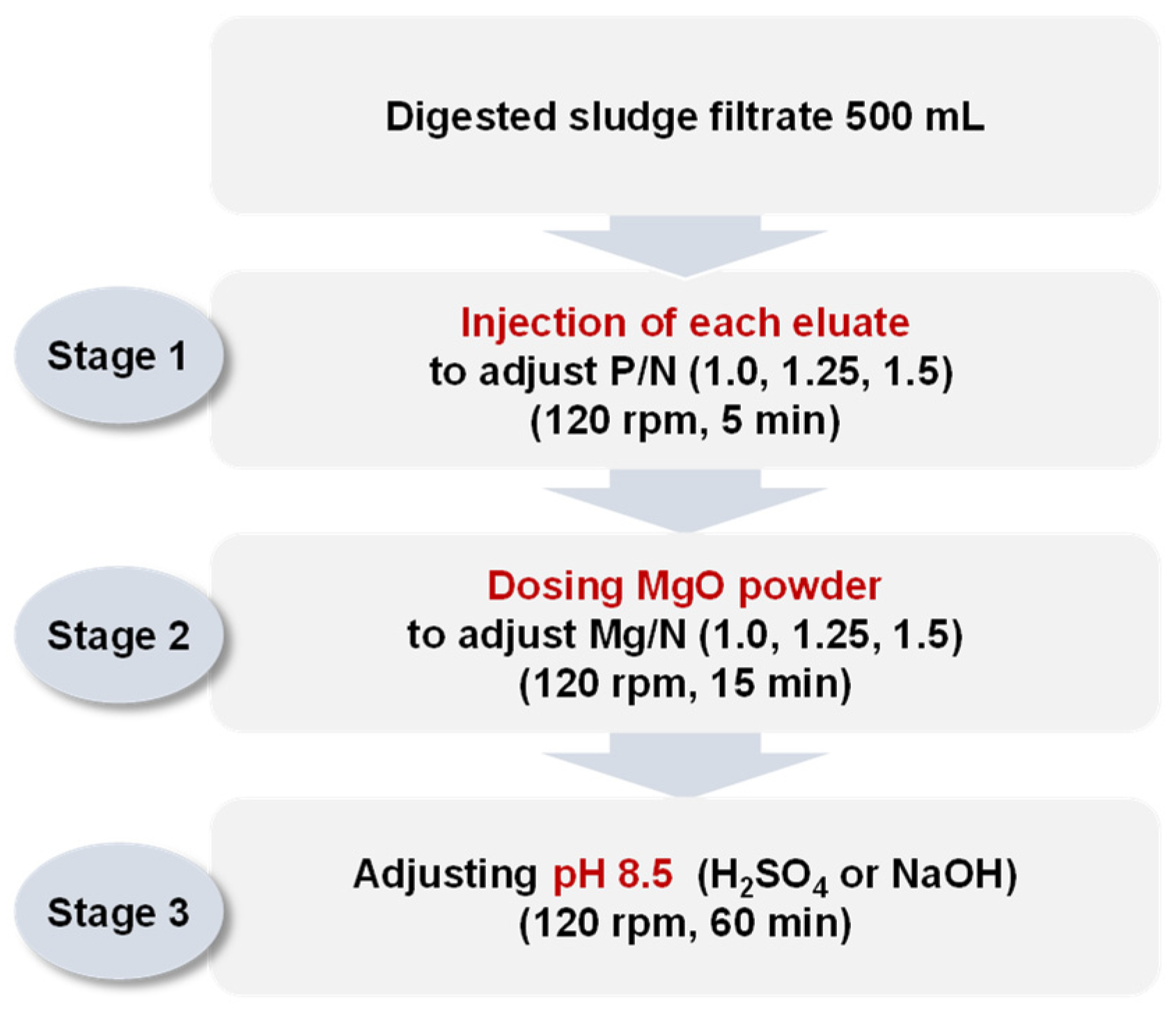

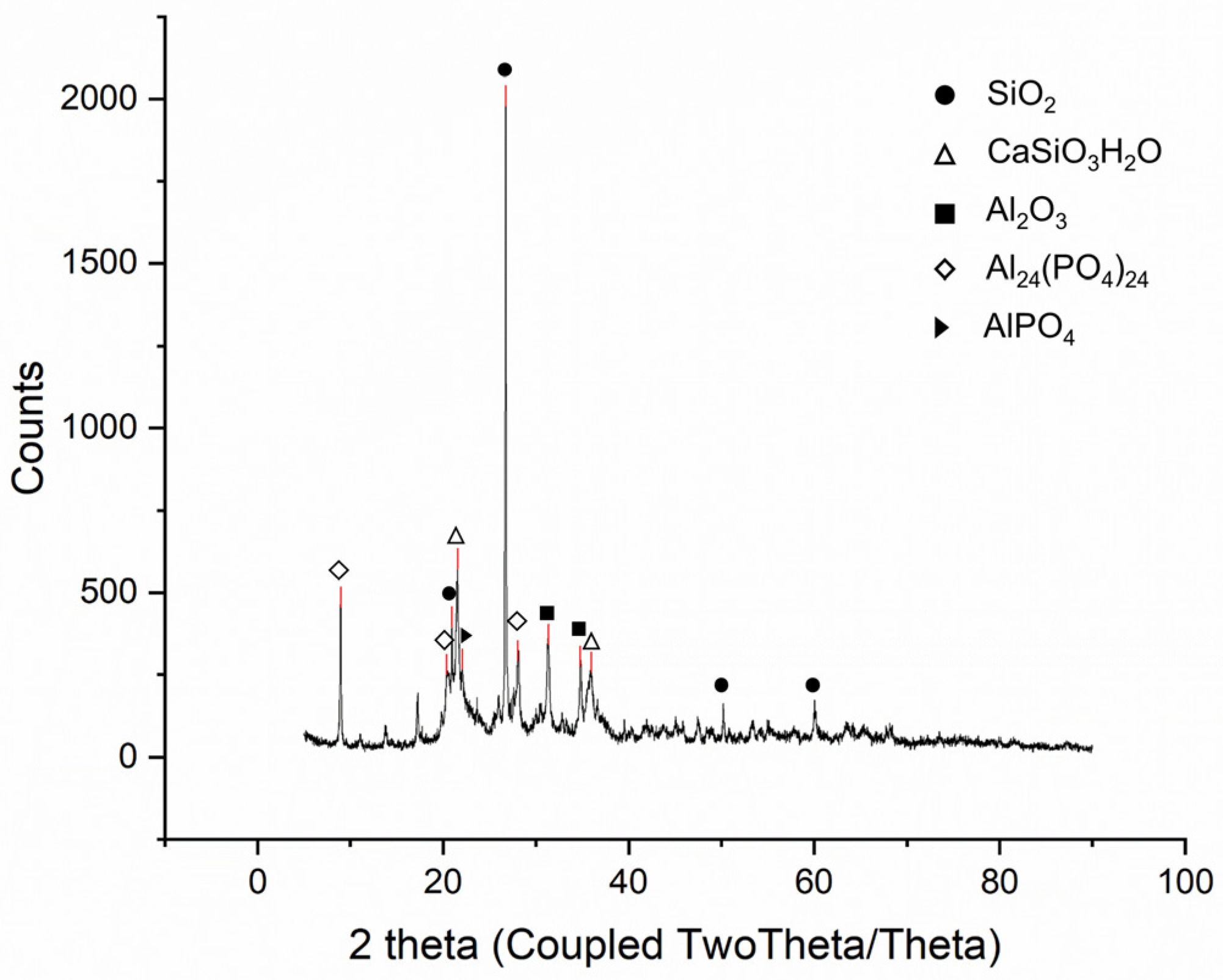


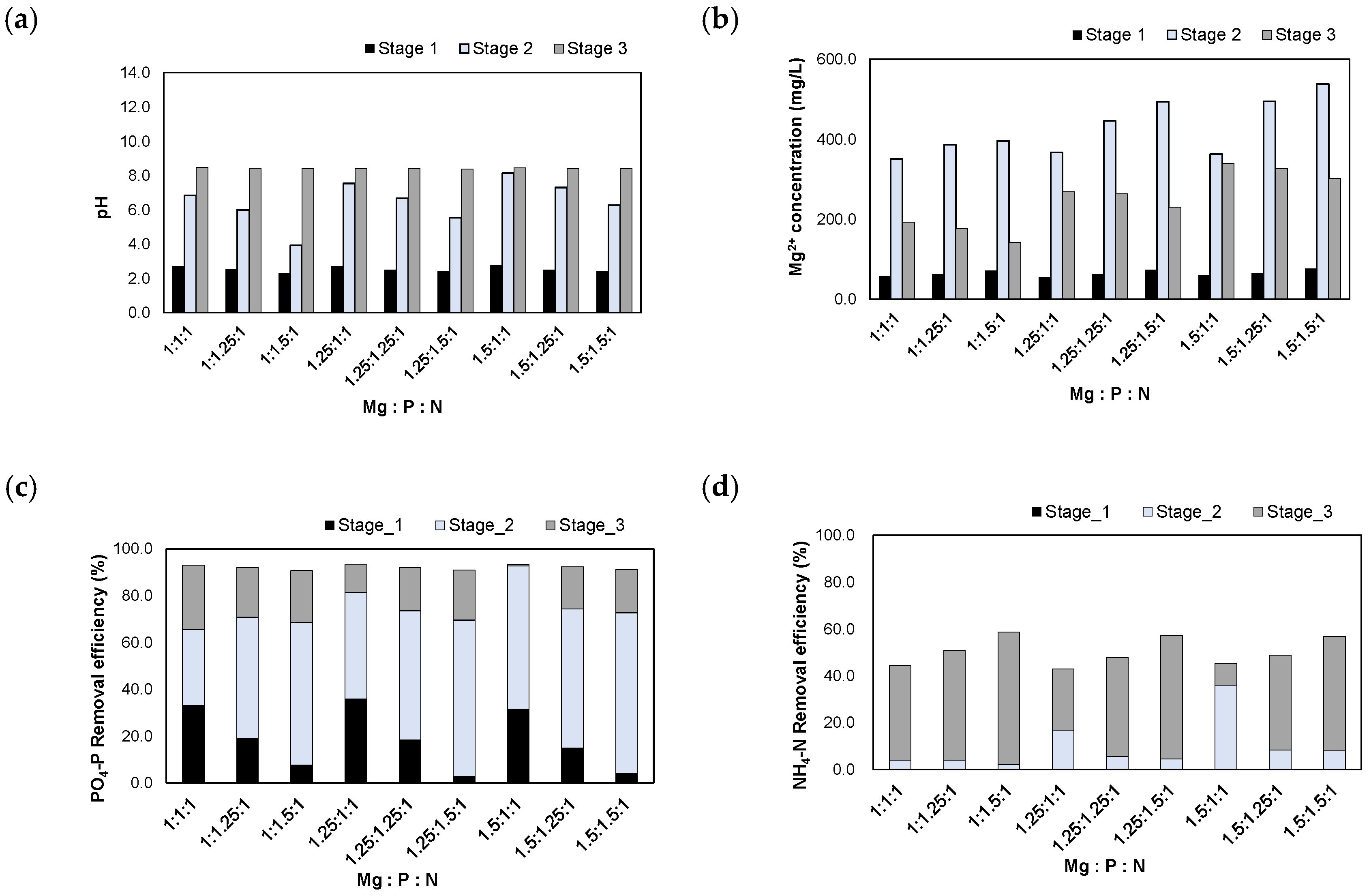

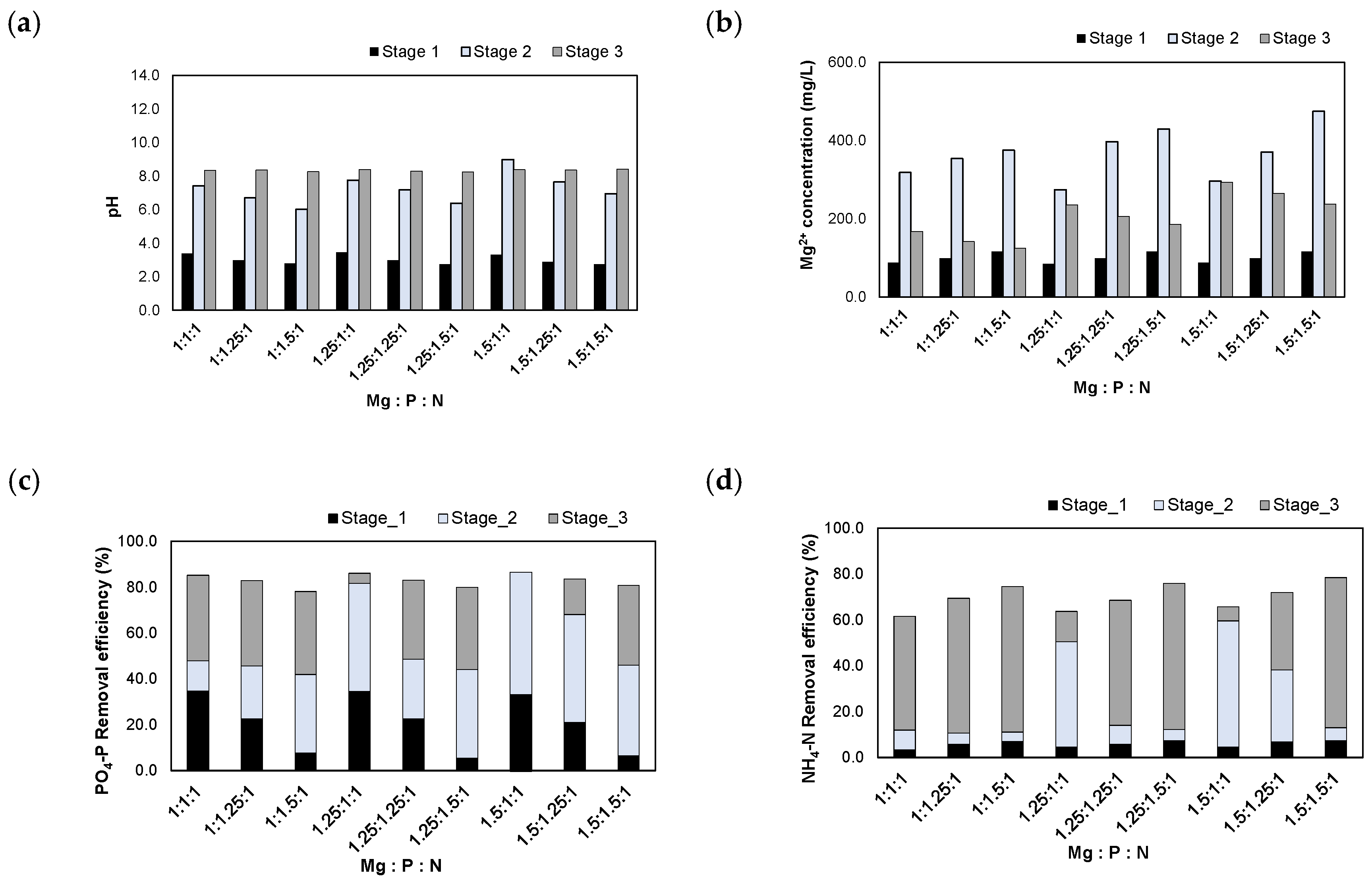

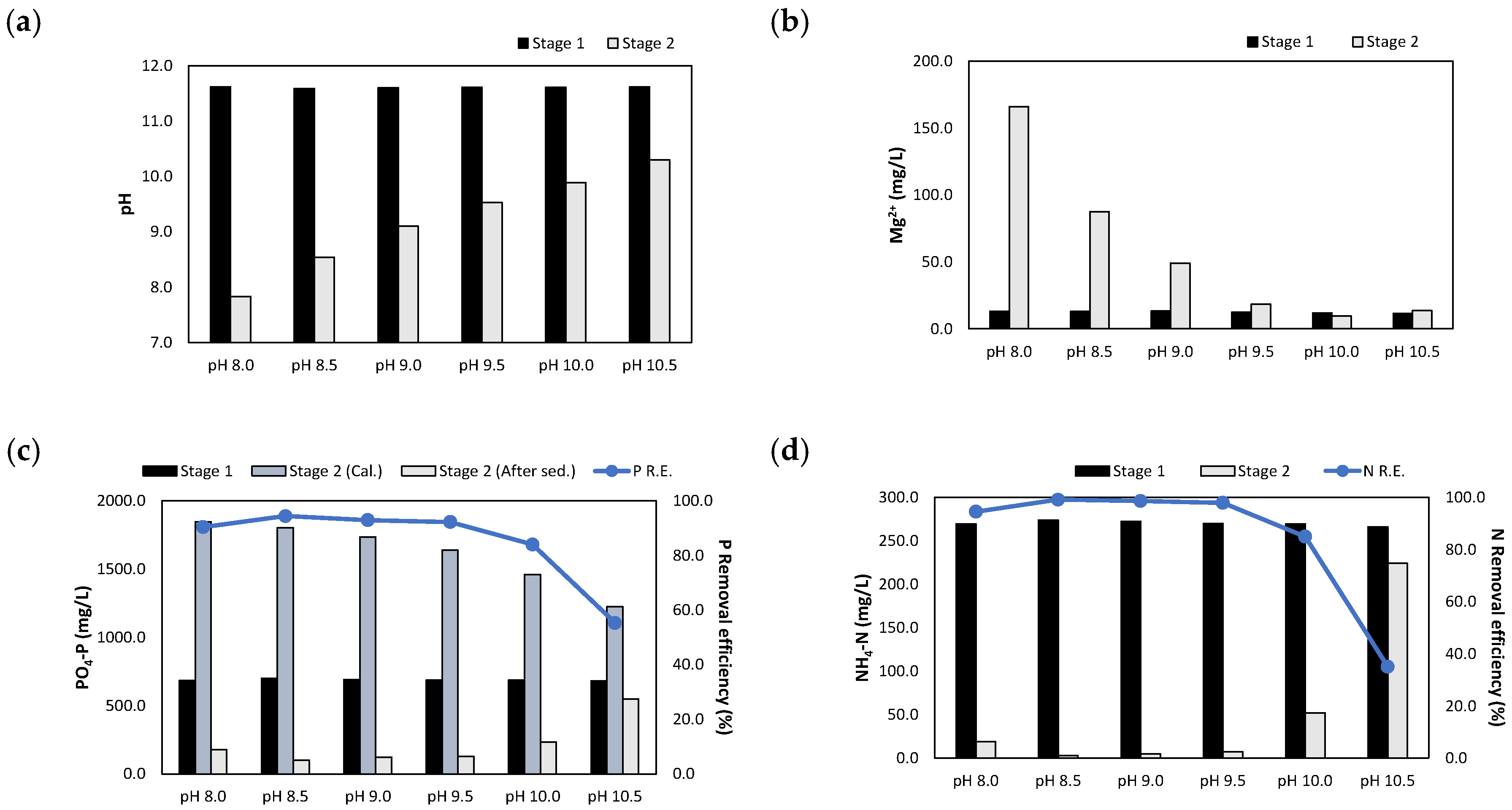
| Chemicals | Concentration (wt %) |
|---|---|
| Al2O3 | 25.08 |
| P2O5 | 24.95 |
| SiO2 | 21.89 |
| CaO | 11.04 |
| Fe2O3 | 8.27 |
| MgO | 2.88 |
| K2O | 2.38 |
| Na2O | 1.11 |
| TiO2 | 0.67 |
| SO3 | 0.67 |
| ZnO | 0.43 |
| BaO | 0.18 |
| CuO | 0.16 |
| MnO | 0.11 |
| SrO | 0.06 |
| Cl | 0.06 |
| Cr2O3 | 0.02 |
| PbO | 0.01 |
| NiO | 0.01 |
| ZrO2 | 0.01 |
| Rb2O | 0.01 |
| Bi2O3 | 0.01 |
| Total | 100.01 |
| Heavy Metals | H2SO4 1 N (mg/kg_SSA) | NaOH 1 N (mg/kg_SSA) |
|---|---|---|
| Cd | 0.1 | ND |
| Cu | 623.0 | 5.0 |
| Pb | 1.5 | 0.3 |
| Zn | 276.4 | 9.0 |
| Ni | 3.4 | ND |
| As | 15.7 | 4.5 |
| Cr | 9.7 | 0.5 |
| Mn | 481.8 | 0.1 |
| Fe | 5155.4 | 7.4 |
| Al | 57,026.5 | 46,346.2 |
| pH of Re-Eluate | PO4-P (mg/L) | Total Leaching P (%) | |
|---|---|---|---|
| NaOH 1 N_eluate | (NaOH+H2SO4)_eluate | ||
| pH 1.5 | 5640 | 5040 | 98.0% |
| pH 1.75 | 5660 | 4160 | 90.1% |
| pH 2.0 | 5660 | 2440 | 74.4% |
| pH 3.0 | 5600 | 240 | 53.6% |
| Heavy Metals (unit: mg/kg_SSA) | pH | |||
|---|---|---|---|---|
| 1.5 | 1.75 | 2.0 | 3.0 | |
| Cd | 2.7 | 2.5 | 1.5 | 0.4 |
| Cu | 591.1 | 491.7 | 349.9 | 38.6 |
| Pb | 1.6 | 0.2 | ND | ND |
| Zn | 249.4 | 176.5 | 135.5 | 35.0 |
| Ni | 2.6 | 2.1 | 1.8 | 0.6 |
| As | 8.8 | 8.8 | 7.8 | 4.3 |
| Cr | 5.4 | 4.1 | 1.8 | 0.3 |
| Mn | 429.0 | 389.0 | 278.3 | 50.7 |
| Fe | 2273.9 | 856.7 | 508.0 | 0.2 |
| Al | 20,883.0 | 14,004.6 | 9057.8 | 65.0 |
| Raw Water, Eluates | Mg2+ (mg/L) | PO4-P (mg/L) | NH4-N (mg/L) |
|---|---|---|---|
| Digested sludge filtrate | 12.2–31.2 (Avg.: 26.2) (Std.: 7.0) | 86.0–148.5 (Avg.: 109.3) (Std.: 23.2) | 222.0–345.6 (Avg.: 271.8) (Std.: 51.1) |
| H2SO4 1 N_eluate | 603.1–768.8 (Avg.: 685.0) (Std.: 81.8) | 10,235–10,648 (Avg.: 10,441) (Std.: 206) | - |
| NaOH 1 N_eluate | 21.2–38.6 (Avg.: 29.9) (Std.: 8.7) | 5944–5997 (Avg.: 5970) (Std.: 26) | - |
| (NaOH+H2SO4) _eluate (pH 1.5) | 589.8–678.4 (Avg.: 634.1) (Std.: 44.3) | 4610–4767 (Avg.: 4688) (Std.: 79) | - |
| Eluate | Mg:P:N | Crystal (%) | Amorphous (%) |
|---|---|---|---|
| H2SO4 1 N_eluate | 1:1:1 | 33.9 | 66.1 |
| 1.25:1:1 | 35.2 | 64.8 | |
| 1.5:1:1 | 35.4 | 64.6 | |
| NaOH 1 N_eluate | 1:1:1 | 39.6 | 60.4 |
| 1.25:1:1 | 36.2 | 63.8 | |
| 1.5:1:1 | 36.2 | 63.8 | |
| (NaOH+H2SO4) _eluate | 1:1:1 | 43.4 | 56.6 |
| 1.25:1:1 | 48.3 | 51.7 | |
| 1.5:1:1 | 49.6 | 50.4 |
Disclaimer/Publisher’s Note: The statements, opinions and data contained in all publications are solely those of the individual author(s) and contributor(s) and not of MDPI and/or the editor(s). MDPI and/or the editor(s) disclaim responsibility for any injury to people or property resulting from any ideas, methods, instructions or products referred to in the content. |
© 2024 by the authors. Licensee MDPI, Basel, Switzerland. This article is an open access article distributed under the terms and conditions of the Creative Commons Attribution (CC BY) license (https://creativecommons.org/licenses/by/4.0/).
Share and Cite
Park, N.; Kim, M.; Jung, J.; Ji, S.; Kim, W. New Strategy to Maximize Phosphorus Utilization of Sewage Sludge Incineration Ash for Struvite Crystallization. Water 2024, 16, 1682. https://doi.org/10.3390/w16121682
Park N, Kim M, Jung J, Ji S, Kim W. New Strategy to Maximize Phosphorus Utilization of Sewage Sludge Incineration Ash for Struvite Crystallization. Water. 2024; 16(12):1682. https://doi.org/10.3390/w16121682
Chicago/Turabian StylePark, Nari, Miseon Kim, Jinhong Jung, Sanghoon Ji, and Weonjae Kim. 2024. "New Strategy to Maximize Phosphorus Utilization of Sewage Sludge Incineration Ash for Struvite Crystallization" Water 16, no. 12: 1682. https://doi.org/10.3390/w16121682
APA StylePark, N., Kim, M., Jung, J., Ji, S., & Kim, W. (2024). New Strategy to Maximize Phosphorus Utilization of Sewage Sludge Incineration Ash for Struvite Crystallization. Water, 16(12), 1682. https://doi.org/10.3390/w16121682







